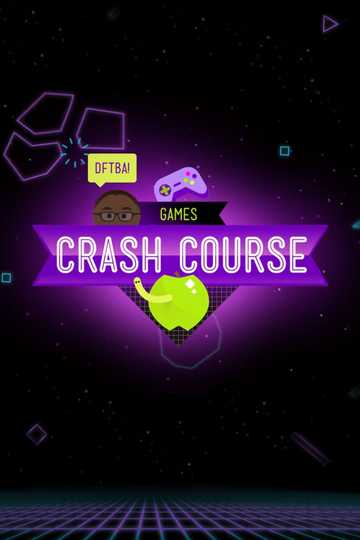Games Plot
In 29 episodes, Andre Meadows will teach you about games! This course was developed with The Art of Game Design: A Book of Lenses by Jesse Schell as a main reference text. By the end of this course, you will be able to: * Comprehend, interpret, and analyze texts, games, animations, and imagery * Discuss game-related problems and solutions in group settings * Contextualize games according to historical period and psychological underpinnings * Understand how games are developed and how consoles and companies change over time * Apply concepts to particular games and to examples from everyday life
Crash Course Games Games aired on March 31st, 2016.
Games Episodes
1. What is a Game?
Welcome to Crash Course Games! In this series our host Andre Meadows is going to discuss the history and science of games. We’re going to talk about video games of course, but also board games, role playing games, card games, even sports! But before we get ahead of ourselves we are going to look at what a game actually is, who is playing these games, and what they are doing to us. It turns out these answers aren’t as obvious as they would seem, but one thing is definitely clear: games make up a huge portion of most peoples’ lives, and we think that can be a great thing!
2. Ancient Games
From the ancient Egyptian game of Senet to the Aztec’s Patolli, games have been played since the beginning of civilization. Today, your host Andre Meadows is going to take a look at a few of these games, including some that are actually still played today, and talk about how they’ve influenced our modern board and video games and why they have had such staying power.
3. The Dawn of Video Games
Over the next few episodes we’re going to talk about the history of video games. Today, we’re going to start with the first re-programmable computers in the 1940’s. Now, these computers were serious tools. They were for codebreaking and calculating artillery tables during World War II - but like most tools we human use, we eventually looked for ways to make them playthings. And over the next three decades the advances of computer technology and the tentative curiosity of many engineers and programmers would inspire a new culture and eventually the first true coin-operated video game in 1971.
4. Atari and the Business of Video Games
Today, Andre is going to talk about the rise of Atari and with it the rise of the video game industry.
5. The First Home Consoles
So last week Andre talked about Atari’s role in the rise of the video game industry, but Atari wasn’t the only major player in the 1970s. So we’re going to step back a few years and first talk about Ralph Baer who designed the first video game console - the Magnavox Odyssey. The Odyssey would go on to inspire the industry including of course Atari but also Mattel and many others. This was the start of the first console wars and with it we see huge improvements in graphics, gameplay, and of course better storytelling. But we’ll also see a flooding of the market which will have a cost, but we’ll get to that next week.
6. The Video Game Crash of 1983
So the 1980s was the golden age of arcade games. Games like Donkey Kong, Pac- Man, Space Invaders, and Centipede had become a cultural phenomenon. These games had expanded the gamer demographic and even encouraged the rise of competitive gaming. There were also many innovations in the home console and computer market with deeper and longer games like Pitfall and Castle Wolfenstein. Suddenly, you could play a game for much longer than your single quarter could get you on an arcade machine. So the video game industry was booming, but it had also become a sort of Wild West and everyone from Purina to Quaker wanted to get into the action. With these new creators came a glut of choices, and to remain competitive Atari began rushing games to market resulting in some truly terrible games. Gamers started to lose confidence in the industry and then in 1983 the gaming industry in the United States crashed.
7. Nintendo and a New Standard for Video Games
So we ended the last episode at the North American Video Game Crash of 1983, and even though the video game market had collapsed in the United States, demand for video games remained strong in Europe and Asia.
8. Sega and More Mature Video Games
So we ended the last episode nearing the close of the 1980s and Nintendo had become the dominant player in the home console market, but Sega, originally a slot machine game company during World War 2, was looking to get its own console into players’ homes. Sega’s first console wouldn't see much success, but with the introduction of Sonic the Hedgehog on the technologically superior Sega Genesis, Sega established itself as the new best thing in video games. This would be the start of a new round of console wars and the era that brought us more mature games including fighting games, 1st person shooters, and lots of sports games. This maturation of games also led us to the software ratings system by the ESRB. But Sega and Nintendo would not be the alone in the market for long, next week we’re going to talk about the entrance of technology monolith Sony and their introduction of the Playstation.
9. Playstation and More Immersive Video Games
So by the mid-90s the video game industry was once again booming and this attracted the attention of the Japanese electronics giant Sony. In 1994, Sony introduced their Playstation console which successfully coupled cutting edge technologies with some great games. But Nintendo and Sega weren’t just sitting around. In the 90’s we would see the introduction of the Sega Saturn and eventually the Sega Dreamcast as well as Nintendo’s immensely popular Nintendo 64. And with this new hardware came a new era of immersive games. Games were going 3D, and with the introduction of CD’s, the size of games increased dramatically allowing for much longer and complex storytelling. Local multi-player and split screen games also became popular during this time as consoles such like Nintendo 64 were now powerful enough to support these kinds of social games. And games on the PC were becoming more immersive as first person shooters began to flourish on the platform.
10. Microsoft and Connected Consoles
Today, we wrap up our discussion of the console wars by taking a look at Microsoft’s Xbox which was announced in 2001. The early 2000s saw a lot of innovation in hardware and games and we’ll cover some of that, but one significant change that would heavily influence the industry was actually pioneered by that doomed Sega Dreamcast was Internet connectivity. Sony’s Playstation 2, released in 2000, and Nintendo’s GameCube, released in 2001, would also include ways to get online, but Xbox’s implementation of a fully unified network that allowed gamers to compete across consoles was the first of its kind. Now, PCs gamers had been playing across networks, particularly within the popular MMORPG genre, since the mid 90s and we’ll spend a couple episodes taking a closer look at the PC's influence, but today we’re going to focus specifically on how the Internet on consoles helped lead to the prevalence of the competitive gaming and online gaming communities we see today.
11. Casual Gaming
Today, we’re moving on from game consoles to talk about a bigger shift that was happening in the gaming industry. In the mid 2000s, we saw a proliferation of Internet accessible devices and with them gaming would expand to a new audience. We’re going to talk about two types of games that are found on these devices, social and mobile games, which together we’ll call casual games. Now, the definitions of these terms can get a little muddy, as they’re continuously evolving, but largely what was seen in the industry was a widespread adoption of asynchronous, socially driven gameplay. These changes spurred the industry to change its profit model, and by 2015, these casual games now make up nearly half of all video game industry revenue. And with their easier mechanics, lower price point, and social component these casual games helped integrate gaming into our daily lives like never before.
12. MMORPGs
So we ended the last episode with casual gaming and a more connected gaming community, but these connected communities started much before smartphones and Facebook. Today, we’re going to talk about MMORPGs - or Massively Multiplayer Online Role Playing Games.
13. Card Games
Today, we’re going to step away from video games and take a closer look at a game type that has been with us for over a millennium - card games. Since Tang Dynasty China, cards have proven to have quite the staying power spawning a countless variety of games as well largely influencing gaming culture, particularly in games like Poker within the gambling industry and also more recently in trading card game communities around games like Yu-Gi-Oh, Pokemon TCG, and Magic: The Gathering.
14. Board Games
Today, we’re going to talk about board games, but instead of trying to trace their histories, which we’ve already covered a bit of in ep2 on ancient games, we’re going to look really closely at just two board games - Monopoly and The Settlers of Catan. These two games have been played by millions, and we’ll talk about why they’re so popular (and controversial), but more importantly these two games have helped define two approaches to board game design: the American style board game and the European style board game. Now these two different “styles” of board games are mostly just over-generalizations about board game mechanics and there’s a ton of overlap, but with the recent resurgence in board game popularity they help us more clearly define two discrete time periods in board game popularity and discuss how these approaches have been defined by the times.
15. Educational Games
Chess, Number Munchers, The Oregon Trail! Today, we’re going to talk about gaming’s role in education. Now technically all games have an educational component, because games are defined by their rules and players have to learn those rules to participate. But of course there is a subset of games designed to teach players skills useful within but but also outside game worlds. And these kinds of games have actually been around for thousands of years! So today we’re going to focus a few educational game successes, talk about how they got there, and what they have done for us in the process.
16. Psychology of Gaming
So we’ve talked a lot about what makes games so great in this series, but we haven’t really addressed the big question: why do we play games anyway? And well, the answer is pretty complicated, especially when you consider that some people really like card games, others may only like playing baseball, and others may only like watching Minecraft Let’s Play videos But there are reasons behind these preferences and we’re going to talk about them, what these preferences say about ourselves, and look at how these preferences inform the games we play.
17. The Olympics, FIFA, and why we love sports
Today, John Green is going to be your substitute teacher as we dive into the world of sports! Now “sports” is a pretty broad genre of game, we probably couldn’t even cover them in an entire series, but today we’re going to do our best to look at the origins of sports as they trace their histories back the Olympics (and even a little earlier), and look at how the rise of national pride and gaming communities has led us to the cultural behemoth of the FIFA World Cup. It’s a lot to cover, but we’re do our best to answer the big question for you non-sports-loving-gamers out there along the way: why do we love sports anyway?
18. Role-playing Games
Today, we’re going to explore the world of role-playing games. Role-playing games are different than most, because they’re technically a form of interactive storytelling with one player managing the game as the game master (or dungeon master), and all of players assuming the roles of their characters. These games started within the genre of wargaming, but reached widespread popularity relatively recently in the 1970s and 80s with its incredibly popular fantasy-based entry Dungeons & Dragons. But with this rise in popularity also came controversy. The United States during this time saw RPGs as an attack on morality and religion and even claimed that these games lured its players into Satanism and black magic.
19. Game Design
Good game design is essential for a positive player experience whether it’s a board games, video game, or even dice game. So today, we’re going to take some time to give you an introductory overview of the process of creating a game, and talk about some of the popular design strategies game creators take to ensure a fun experience for players. Now these are all theories, and there are plenty of games that break the common “rules” of good game design, but hopefully it’ll give you a better sense of how and why we love certain games so much.
20. PC Gaming
Today, we're FINALLY going to talk about PC Gaming. So the personal computer is the precursor to the console, but it's not quite accurate to say that it just led to the console. PCs and the video games created on them have and continue to influence the rest of the video game industry. The PC was the first to bring gamers a number of experiences from adventures in Myst, to first person shooters in Wolfenstein 3D, and of course real-time strategy games with Dune II. And the PC platform continues to grow and thrive with genres that are best and sometimes only possible on this platform.
21. The Future of Virtual Reality
Today, we’re going to take a look at a seemingly cutting-edge technology that has actually been around for decades - virtual reality. Virtual reality devices have been introduced multiple times in the video game era, but they never seem to stick. But why is that? To try to answer this question we’re going to trace the origins of virtual reality all the way from panoramic paintings in 12th century China to the present and hopefully it will better inform what the future holds for this gaming technology.
22. Open World Games
Today we’re going to talk about open world games. Open world games are different than most video games because although they often have goals and tasks, they usually encourage what is known as “emergent stories.” These are stories that weren’t planned by the game creators, but players create within the constructs of the game. And this leads to a completely different type of gameplay encouraging players to explore as well as socialize with others. Now, these types of games have been around for a while, but within the past couple decades they’ve seen incredible growth with games like Minecraft, Skyrim, and Grand Theft Auto, and this isn’t by accident - open world game also mirror the growth of the hardware that supports them.
23. Handhelds
Today, we’re going to talk about the gaming devices that combine the screen, speakers, controls, and computer into one neat little package - that’s right we’re talking about handheld game consoles. Handhelds have actually been around since the mid 1970s, and they’ve made some incredible strides within the past few decades from blinking lights to glasses free 3d and even console-equivalent graphics. But even with their early successes their future isn’t so certain. The early market saw the rise of Nintendo, Sony, and Sega, but has since been whittled down to just to Nintendo. And although the Game Boy, and Nintendo DS handhelds have sold incredibly well, mobile gaming seems to be eating away at Nintendo’s market.
24. Input Devices
Today we’re going to talk about controllers. Controllers are incredibly important in the gaming experience because they are how we communicate actions within a game and often play a significant role in why we like or dislike certain games. And over the years they have seen some huge improvements mostly brought on by the creation of more complex and immersive video games. Controller design is so important in fact that some of the largest game console manufacturers spend hundreds of millions of dollars each cycle trying to update and refine their designs. But interestingly, the same can’t quite be said for one of the biggest gaming platforms right now - so we’ll talk about that too.
25. The History of Game Shows
Today we're going to talk about game shows! Game shows have a long history going all the way back to the 1920s on the radio and then proliferating across media to the massive pop culture icons they are today. And they're different from most game genres we've discussed in this series because chances are most of us won't participate in shows like Jeopardy!, American Idol, or The Price is Right. Even so, many us are innately familiar with them and actively watch them, much like sports. So today we're going to talk about the winding history game shows, the event that nearly ended the genre altogether, and of course take closer look at why exactly they've become so popular.
26. LARP
Today we’re going to talk about LARPs or live action role-playing games. Larping tends to conjure up the image of a bunch of nerds hitting each other with foam weapons but it’s much more than that. LARPs merge performance, community, and art in a way that allows players to experience different lives within the safe confines of a game. And it isn’t all just medieval battles either, there are LARPs for just about any kind of game scenario you could imagine, and even some that you might not - like those designed to help players better understand the real-world struggles of oppressed populations. And LARPs aren’t just some niche game, LARPs are played in over 80 countries, and are growing rapidly in participation all over the world.
27. Gambling
Today we’re going to talk about gambling. Now, gambling is interesting because it could be argued that gambling doesn’t even have anything to do with games. It’s usually about making money after all - which makes it much closer to work. But gambling definitely has a gaming component from its uncertain outcomes to rules of play, and gambling has had a huge impact on the more traditional games we see today. So let’s take a look at gambling’s not-so-certain history all the way from antiquity to the present, and maybe along the way we’ll try to figure out why we like playing these “games” so much anyway.
28. The Pokémon Phenomenon
Today we’re going to do something a little bit different and take everything we’ve learned so far and apply it to a case study on (arguably) the biggest game franchise in the world: Pokémon. Now Pokémon, like a select few other games we’ve discussed in this series has ingrained itself into our pop culture, but the way Pokémon has done this, and the extent of its reach into almost every genre of gaming is what makes it such a phenomenon. But interestingly, Pokémon’s success wasn’t only by chance.
29. The Future of Gaming
Welcome to the FINAL LEVEL of Crash Course Games! We thought it made the most sense to sign off this series by taking a look towards the future because you know... boss battles are supposed to be tough. Now we don’t know the future obviously, so this episode is going to be a bit more speculative than we’re used to, but we’re going to do our best to recap what we’ve learned throughout this series and try to use that information to make inferences about what is to come. This series has been a joy to make by everyone involved and we collectively wanted to say thank you so much for playing along.


















